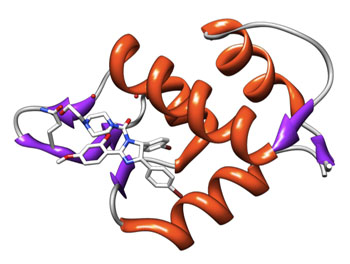Unraveling the Molecular Interactions That Enable Nutlin-Class Drugs to Kill Cancer Cells
By LabMedica International staff writers
Posted on 01 Mar 2016
Loss of the PUMA (p53 upregulated modulator of apoptosis) gene has been shown to protect tumor cells from being killed by the Nutlin class of experimental anticancer drugs.Posted on 01 Mar 2016
Nutlins are cis-imidazoline analogs that inhibit the interaction between the enzyme mdm2 (mouse double minute 2 homolog) and the tumor suppressor protein p53. MDM2 is an E3 ubiquitin-protein ligase that binds to p53 and targets it to ubiquitin-mediated degradation in proteasomes. Inhibiting the interaction between mdm2 and p53 stabilizes p53 and is thought to selectively induce a growth-inhibiting state called senescence in cancer cells. These compounds are therefore thought to work best on tumors that contain normal or "wild-type" p53. Nutlin3a, which is the forerunner of a class of cancer therapeutics that have reached clinical trials, has been shown to affect the production of p53 within minutes.

Image: Binding of a Nutlin to the enzyme mdm2 (shown in red) (Photo courtesy of the BioChemoInformatics Lab, Bologna, Italy).
Investigators at the Walter and Eliza Hall Institute (Melbourne, Australia) used transgenic and gene-targeted mouse models lacking the critical p53 target genes, p21, Puma, and Noxa (phorbol-12-myristate-13-acetate-induced protein 1) to study the interactions involving Nutlin3a, mdm2, and PUMA.
The investigators reported in the February 18, 2016, online edition of the journal Cell Reports that only loss of PUMA conferred profound protection against Nutlin3a-induced killing in both non-transformed lymphoid cells and in lymphoma cells in vitro and in vivo. In addition, CRISPR/Cas9-mediated targeting of the PUMA gene rendered human hematopoietic cancer cell lines markedly resistant to Nutlin3a-induced cell death.
These results demonstrated that PUMA-mediated apoptosis, but not p21-mediated cell-cycle arrest or senescence, was a critical determinant of the therapeutic response to p53 activation by Nutlin3a. Importantly, in human cancer, PUMA expression may predict patient responses to treatment with drugs that target mdm2.
"When functioning properly, p53 is activated in response to early cancerous changes in the cell," said senior author Dr. Andreas Strasser, a professor in the molecular genetics of cancer division at the Walter and Eliza Hall Institute. "P53 acts by either halting the cell while repairs are made or by forcing the cell to die if it cannot be repaired. Without the "help" of P53, a damaged cell can be allowed to multiply, leading to cancer development. P53 lies dormant in many types of cancer that do not have mutations in P53, and the nutlins work through re-awakening its activity. By understanding how nutlins are killing cancer cells, we can begin to formulate their best possible use, including choosing the best partner drugs to combine the nutlins with."
Related Links:
Walter and Eliza Hall Institute














